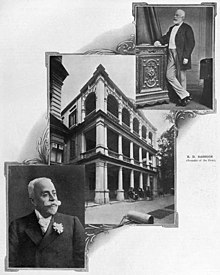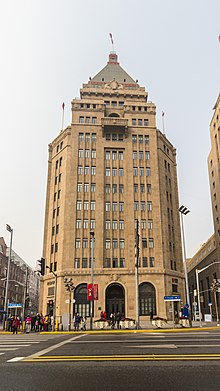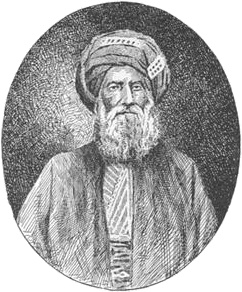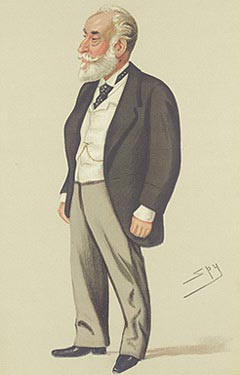

E.D. Sassoon & Co., Ltd. was a trading company operating in the second half of the 19th century and the first half of the 20th century predominantly in India, China and Japan.


E.D. Sassoon & Co., Ltd. was a trading company operating in the second half of the 19th century and the first half of the 20th century predominantly in India, China and Japan.
E.D. Sassoon & Co., Ltd. was founded in 1867 by Elias David Sassoon (1820–1880), the second son of David Sassoon (1792–1864), after he had broken away from his family's company, David Sassoon & Co., because of personal resentments between him and his brothers. The new company started to trade in dried fruits, namkeen, metals, tea, silk, spices and camphor from modest offices in Bombay and Shanghai. [1] But it soon focused on exporting opium, cotton and fabrics from India to China. [2]
E.D. Sassoon & Co. soon proved to be more energetic than David Sassoon & Co. and by the later Edwardian years its capital was two to three times as much (£1.25m to £1.5m) as the nominal capital of David Sassoon & Co. (£0.5m). [3] The company later expanded its operations to the Persian Gulf ports, Baghdad and Japan. From 1879 [4] onwards it also bought up poorly performing cotton mills in Bombay and turned them into successful operations.[ citation needed ]
After the death of Elias David Sassoon in 1880, his eldest son Sir Jacob Elias Sassoon (1844–1916) took over the business and further branches were opened in Calcutta and Karachi. The firm also purchased property in Shanghai. But in 1907 the United Kingdom signed a treaty agreeing to gradually eliminate the opium exports to China over the next decade while China agreed to eliminate domestic production over that period. Following this treaty E.D. Sassoon & Co. retreated from the opium trade, eventually stopping it completely. [5] Instead the company invested further in its cotton mill business in Bombay. By the First World War E.D. Sassoon & Co. had grown into India's single largest textile group and was renowned for their advanced production technology.[ citation needed ]
In 1909 Sir Jacob Elias Sassoon also played a very prominent role in forming the "Eastern Bank", taking advantage of the banks facilities to make themselves less vulnerable to fluctuations of the Indian rupee. On 1 January 1921, E.D. Sassoon & Co. Ltd was incorporated as a private trading and banking company, giving up its old partnership structure. [6]
After the death of Sir Edward Elias Sasoon (1853–1924) and his younger brother Meyer Harry Sassoon (1875–1924) within a year, Sir Edward Elias Sassoons son Sir Victor Sassoon (1881–1961) and Meyer Harry Sassoon's widow Mozelle Gubbay (1872–1964) became the main owners of the company with combined business assets of £15 million. Sir Victor Sassoon became the chairman of the company and Meyer Harry Sassoon's son-in-law, Derek Fitzgerald (1892–1967), was appointed manager of the London and Manchester branches.[ citation needed ]
In 1927, E.D. Sassoon & Co. Ltd was already the largest cotton mill owner in Bombay, where it was still headquartered. When the Great Depression in 1929-30 drove E.D. Sassoons biggest competitors into bankruptcy, the company took them over. By the time the Second World War broke out in Europe, E.D. Sassoon & Co. owned 15 cotton mills and was with over 30,000 employees Bombays largest private employer.[ citation needed ]
The profits generated in Bombay were reinvested in luxury real estate and hotels in Shanghai. In 1923 E.D. Sassoon & Co. had bought the majority of shares of the established produce firm "Arnhold & Co." [7] of Shanghai, which in turn controlled the "Cathay Land Company". The latter owned several apartment buildings and a hotel in Shanghai and offered the perfect basis for further investments in Shanghai property. [8]
In 1928 Sir Victor Sassoon established the "E.D. Sassoon Banking Company Limited" as a subsidiary of "E.D. Sassoon & Co. Ltd", to coordinate the trading interests of his family. [9] In March 1930 E.D. Sassoon & Co. new headquarter was opened at "Sassoon House" in Shanghai.
The Second World War brought many changes to the E.D. Sassoon Group. Although the war boosted production rates, thanks to the soaring demand of the allied armies, the firm decided to dispose of the cotton mills in Bombay in 1943, [10] fearing problems as foreign owners once independence to India was granted. In May 1949 Shanghai was under the control of a communist regime and seemed an unhealthy place for the company's head office, so this was transferred to Nassau in the Bahamas in 1950. It is thought that Nassau was chosen because there were no forms of personal or corporation tax in place and Sir Victor Sassoon planned to live there, which he did until his death in 1961. [11]
After Sir Victors Sassoons death the banking subsidiary, E.D. Sassoon Banking & Co. Ltd., was sold in 1972 to the merchant bank "Wallace Brothers & Co. (Holdings) Ltd" and renamed "Wallace Brothers Sassoon Bank Ltd." in November 1974, which in turn was taken over by the Standard Chartered Bank in 1976. [12] The parent company, E.D. Sassoon & Co., continued to operate as a separate company from 1972 until 1978 when it became "DK Investments (Crosby Square) Ltd." (4 Crosby Square, City of London).
The "Sir Victor Sassoon Heart Foundation", set up by Lady Sassoon after her husband's death, are run from Nassau, where the family still lives.[ citation needed ]

Sir Philip Albert Gustave David Sassoon, 3rd Baronet, was a British politician, art collector, and socialite, entertaining many celebrity guests at his homes, Port Lympne Mansion, Kent, and Trent Park, North London. He served as a staff officer during the First World War, from July 1914 to November 1918.

Sir Jamsetjee Jejeebhoy, 1st Baronet,, also spelt Jeejeebhoy or Jeejebhoy, was an Indian-Parsi merchant and philanthropist, later a British knight and baronet. He made a huge fortune in cotton and the opium trade with China.
Sir Ellice Victor Sassoon, 3rd Baronet was an Italian businessman and hotelier from the wealthy Baghdadi Jewish Sassoon merchant and banking family.

The former communities of Jewish migrants and their descendants from Baghdad and elsewhere in the Middle East are traditionally called Baghdadi Jews or Iraqi Jews. They settled primarily in the ports and along the trade routes around the Indian Ocean and the South China Sea.

David Sassoon was the treasurer of Baghdad between 1817 and 1829. He became the leader of the Jewish community in Mumbai after Baghdadi Jews emigrated there.

Sir Albert Abdullah David Sassoon, 1st Baronet, was a Baghdad-born businessman and philanthropist.

The Broadway Mansions is a nineteen-floor Art Deco five-star hotel in Shanghai, China. and was for over five decades one of the primary symbols of Shanghai.

Sassoon David Sassoon was a British Indian businessman, banker, and philanthropist.

Jews were among the first settlers after Hong Kong became a British colony in 1841. The first Jews arrived in Hong Kong from various parts of the British Empire as merchants and colonial officials. Among the first wave, the Baghdadi Jews stood out especially, including representatives of the influential families of Sassoon and Kadoorie. The construction of the Ohel Leah Synagogue in 1901 marked the beginning of a fully fledged religious life for the city's local Jews.

The Sassoon family, known as "Rothschilds of the East" due to the immense wealth they accumulated in finance and opium trade, are a Baghdadi Jewish family.

Elias David Sassoon, an Indian merchant and banker born in Baghdad, was the second son of David Sassoon, an Iraqi-Indian philanthropist Jewish businessman involved in trade in India and the Far East, with branches at Calcutta, Shanghai, Canton, and Hong Kong; and his business, which included a monopoly of the opium-trade, extended as far as Yokohama, Nagasaki, and other cities in Japan.

Two Sassoon baronetcies were created, in 1890 and 1909 respectively, for members of the Anglo-Indo-Iraqi and Indo-Iraqi branches of the Sassoon family of Baghdadi Jewish descent.

Sir Sassoon Jacob Hai David, 1st Baronet, was an Indian merchant who was a member of the community of Baghdadi Jews who lived in Bombay from the late 19th century into the 20th century. He was a textile mill-owner and merchant who also became Chairman of the Bank of India.

Silas Aaron Hardoon was a wealthy businessman and well-known public figure in the city of Shanghai in the early 20th century.

Harry Edward Arnhold was for five years the chairman of the Shanghai Municipal Council, the body that administered the Shanghai International Settlement in Shanghai, China; the chairman of Arnhold & Co., which is now Arnhold Holdings Ltd.; and the chairman of the Shanghai Land Investment Company, which owned the Broadway Mansions apartment building in the Hongkou District of Shanghai. Arnhold was a close business associate of Sir Victor Sassoon, and managed various Sassoon enterprises.
Arnhold Holdings Ltd is a public company listed on the Hong Kong Stock Exchange and is a leading name in the distribution of building materials and engineering equipment in China. It is the corporate descendant of Arnhold, Karberg & Co., a company founded in 1857, and prominent "amongst the merchants who have contributed largely to the development of China's commerce" in the late nineteenth and early twentieth centuries. Employing more than 650 people, its headquarters has been in Hong Kong since 1949, with sales offices in both Shanghai and Macau.

David Sassoon & Co., Ltd. was a trading company operating in the 19th century and early 20th century predominantly in India, China and Japan.
Frederick David Sassoon was an India-born Anglo-Jewish merchant and banker in Hong Kong and China.
Seth Ramnarain Ruia was an Indian businessperson. He is also referred as the Cotton King.
The Wallace brothers were the six sons of Edinburgh architect Lewis Wallace. In varying combinations, the brothers established themselves as one of the leading nineteenth century East India merchants, trading in cotton, tea, coffee and other commodities. Through their investments in Burma, they became the world's leading exporter of teak. The rise of independent governments after World War II meant the progressive loss of the family's Eastern assets and the redeployment of capital back to London. This capital was used in the 1960s to establish Wallace Brothers as a banking house but this strategy did not long survive the secondary banking crisis of 1973-75.